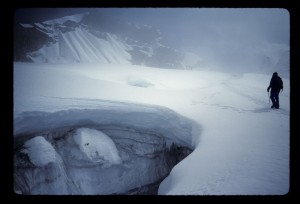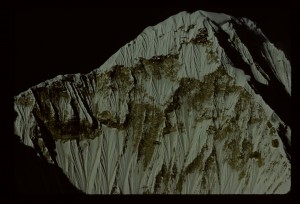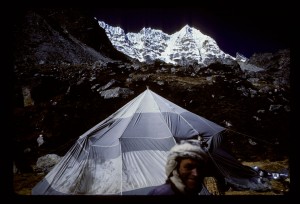Claude Debussy: Reflets dans l’eau (Reflections in the water), from Images, Book I, 1905.
Listen to the full track
Listen to the author reading the text
Not just an onomatopoetic water piece, Debussy is interested in imitating not just water sounds, but reflections on water, that is, pictures that float, which don’t necessarily make noises, so the challenge is greater than mere burbles, trickles, and raindrops. Such sounds in nature conjure up a picture in our mind of falling water, or droplets on ponds, or fountains.
 Debussy is dimly focused on interested in surviewing his contents, that is, in suggesting the pictures by the sounds, so obvious water sounds come to fabricate less and less obvious pictures which move and ripple on the water, monsters of the id rising from the deep, where sounds stand in for pictures, interpretations of nature, even philosophy. Music is transformed into grammar, into meaning. Judgements are handed down, a world is set in motion.
Debussy is dimly focused on interested in surviewing his contents, that is, in suggesting the pictures by the sounds, so obvious water sounds come to fabricate less and less obvious pictures which move and ripple on the water, monsters of the id rising from the deep, where sounds stand in for pictures, interpretations of nature, even philosophy. Music is transformed into grammar, into meaning. Judgements are handed down, a world is set in motion.
The bittersweet calm of random drips grows vaster until it rains, a great guilt or terror arises from below until it becomes almost too intense, and suddenly random wind clears the pond’s palette of past memories, a great discordant crisis is reached, flung outside the world of the pond by wild key progressions, and then the drips recur, wiser, sadder, in the great distance, until the final splash is an answer to the unanswerable riddle Debussy has posed, as if the answer to existential void were an almost religious comfort, the reassuring luxe, calme, and volupté of nature. The same drips which ask the questions answer them.
The great American poet and translator Richard Wilbur has written a poem about a midwinter thaw, a brief false summer, which captures the exact spirit of Debussy’s reflections.
A COURTYARD THAW
The sun was strong enough today
To climb the wall and loose the courtyard trees
(For two short hours, anyway)
From hardship of the January freeze.
Their icy cerements decayed
To silken moistures, which began to slip
In glints and spangles down, and made
On every twig a bauble at the tip.
No blossom, leaf or basking fruit
Showed ever such pure passion for the sun
As these cold drops that knew no root
Yet filled with light and swelled one by one
(Or showered by a wingbeat, sown
From windbent branches in arpeggios)
Let go and took their shinings down
And brought their brittle season to a close.
O false gemmation! Flashy fall!
The eye is pleased when nature stoops to art,
Staging within a courtyard wall
Such twinkling scenes. But puzzling to the heart,
This spring was neither fierce nor gay;
This summary autumn fell without a tear;
No tinkling music-box can play
The slow, deep-grounded masses of the year.
 The sad joy of that strong sun lies in the three-note initial theme, surrounded by its echoing chords, chords made up of just those three theme notes, so that every note of the piece reflects every other note, the way a Bach fugue spreads out from its theme, the way a Shakespearean play expands on the initial themes of the first scene, so that the entire play is present in the beginning, as a Beethoven sonata is also entirely latent in its first few measures, or as we can be replicated from one strand of our DNA: in my end is my beginning.
The sad joy of that strong sun lies in the three-note initial theme, surrounded by its echoing chords, chords made up of just those three theme notes, so that every note of the piece reflects every other note, the way a Bach fugue spreads out from its theme, the way a Shakespearean play expands on the initial themes of the first scene, so that the entire play is present in the beginning, as a Beethoven sonata is also entirely latent in its first few measures, or as we can be replicated from one strand of our DNA: in my end is my beginning.
The cold January freeze is the void surrounding the piece, in its strange harmonies which never resolve.
A MEDITATION ON QUANTUM MECHANICS
As with the Liszt Un Sospiro (track 8), hands overlap here as well, as notes crisscross themselves like diamonds on riplets. Roberts says that the great piano teacher Marguerite Long maintained that Debussy thought of the opening of the piece as “a little circle in water with a little pebble falling into it.” As ripples fan out from the center, the way nacre encrusts itself in circles around pearls, or trees grow outwardly in rings.
I am reminded of Douglas Hofstadter’s captivating discussion of Cantor sets in Gödel, Escher, Bach, those mirrors in mirrors which replicate themselves to infinity, as a Beethoven Sonata is a widening gyre around the center of its beginning, expanding into inaudibility. Cantor sets are caused by the fact that particles interact. No particle exists until its relations with other particles are plotted, similar to the plot of Goethe’s roman, Elective Affinities, where people are treated as electrical charges. As Tom Stoppard said,
Things we know about are influenced by things we know little about, which in turn are influenced by things about which we know nothing at all.
Such hypothetical interactions have been scoffed at, but the recent invention of the quantum computer utilizes just these atomic pairs, where to observe an atom is to force it to stabilize, thus making it either positive or negative. At the same time, its twin atom adopts the opposite charge, even if it is quadrillions of light years away, thus evidencing a force faster than the speed of light. Such twinnings of identities may also give ESP a scientific basis in fact. The fact that twins often have simultaneous thoughts would then seem to arise from their shared atoms at birth.
 And so the lowly musician may have some reasonable basis for attempting to draw parallels between notes, to twin themes. Even the notion of being meant for each other may become a certain inexorable atomic truth rather than a romantic bit of nonsense. Here is a poem about the amorous consequence of such dalliance:
And so the lowly musician may have some reasonable basis for attempting to draw parallels between notes, to twin themes. Even the notion of being meant for each other may become a certain inexorable atomic truth rather than a romantic bit of nonsense. Here is a poem about the amorous consequence of such dalliance:
SUBLIMATION
The properties of particles occur in pairs . . .
—Einstein
If we extrapolate the game
Where every snowflake’s not the same,
Where copying is not allowed
And where, in blizzards, two’s a crowd,
Where every strand of DNA’s
Made to hunt for matching strays,
Knowing in its heart of hearts
Precisely which atomic parts
The universe has yet to fake—
That undiscovered flake
Which, being instantaneously built,
Engenders universal guilt
And is shunned by just the sleet
That gave it patterns to repeat,
As if the ice cold eyes
Of snow are nothing more than spies,
Architects who must be killed
When the galaxy is filled,
Stars lobotomized by sudden fame
(Snow by any shape would look the same),
As if automotive genes could care
That a spoke might need a spare,
Or that an axle might require
For its ends a second tire—
But if the absence of an also ran
Is actually a master plan,
And the random nature of the earth
Isn’t random when it turns to birth
(How spontaneous is it when you
Have to order from the menu),
When disorder needs a list,
A program to deny its gist,
And single chaos so depends
On plural structures for its ends
That the snow, inflated air,
Controls the sex life of a pair
That might like eyes just touch
Some other eyes as much
As any one of those
Infinite and sightless snows—
How selfish then to say the twin
Is nature’s kind of alien,
Rejecting what lone couples might
Flow from cloning at first sight.

